DNA is a very important molecule composed of two linked strands that form a double helix. DNA carries the genetic information for the development and functioning of an organism. DNA is replicated and inherited as generations pass. Any complications in the highly regulated process of DNA replication can cause mutations that can, in some cases, develop into life-threatening diseases.
RNA has a similar structure to DNA. However, unlike DNA, RNA is single-stranded. RNA carries the genetic information needed for the proper translation by ribosomes to proteins.
This guide will introduce DNA and RNA, some key terms and definitions, and things you should remember as you prepare for the MCAT.
Let’s get started!
DNA and RNA on the MCAT: What Do You Need to Know?
DNA and RNA are covered in the Biochemistry section of the MCAT.
Introductory biochemistry accounts for 25% of the Biological and Biochemical Foundations of Living Systems section (Bio/Biochem) and 25% of the Chemical and Physical Foundations of Biological Systems section (Chem/Phys).
It’s hard to predict the exact number of questions about DNA and RNA that will appear on the MCAT. However, you can expect them to appear in both the Bio/Biochem and Chem/Phys sections.
Important Sub-Topics – DNA and RNA
We cannot stress enough the importance of DNA and RNA during MCAT prep, as there are so many overlaps in terms of study content that can be made! They can relate to more similar topics such as cell division & viral replication but can also relate to general chemistry topics such as hydrogen bond formation!
DNA and RNA can be complicated, so let’s break them down into important sub-topics you can concentrate on.
1. DNA: Structure & Function
The structure of deoxyribonucleic acid (DNA) is very recognizable due to its double helix, which forms a helical, spiral structure with complementary base pairing between the nucleotides. The two strands that form this observed double helix structure run in the oppositive direction, resulting in an antiparallel orientation. One strand runs from the 5’ to 3’ direction starting from the top, whereas, the other strain runs 5’ to 3’ starting from the bottom.
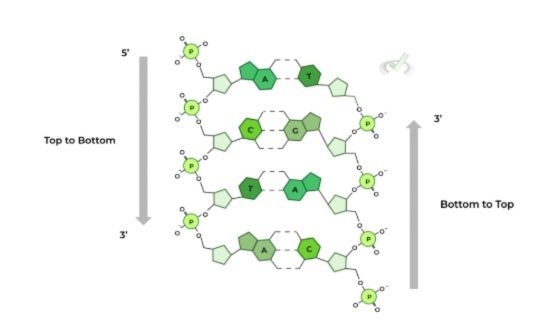
The nitrogenous bases on the nucleotides themselves each have specific base pairs that form this DNA double helix. Adenine (A) pairs with thymine (T), and cystine (C) pairs with guanine (G). According to Chargaff’s rule, corresponding base pairs will have a 1:1 ratio in regard to percentage composition in the DNA molecule. The sum of all individual base pair percentages will equal 100%.

The DNA strands formed by the complementary base pairs can be separated and combined. Denaturation refers to the separation of the double-stranded DNA (dsDNA), whereas reannealing refers to the combining of the separated DNA strands.
Once properly formed, DNA plays a role in many major cellular processes. These include, but aren’t limited to, inheritance, DNA replication, RNA transcription, and mitosis/meiosis.
Full Study Notes : DNA: Structure and Function on the MCAT
For more in-depth content review on DNA structure and function, check out these detailed lesson notes created by top MCAT scorers.
2. DNA Replication
DNA replication can be described as semiconservative as the parent (template) strand from the original DNA molecule is always preserved in the new DNA molecules. However, with each round of DNA replication, the parent strands slowly become outnumbered by the daughter (new) strands.
Daughter strands are ONLY synthesized in the 5’ to 3’ direction. As such there are two different types of daughter strands – leading and lagging strands.
DNA replication originates from regions identified by DNA replication proteins, which commence replication.
To prevent the loss of genetic information after each round of replication, eukaryotic cells use telomeres. These are repeating, noncoding sequences that act as a “cap”.
Full Study Notes : DNA Replication: Key Terms on the MCAT
For more in-depth content review on DNA replication key terms, check out these detailed lesson notes created by top MCAT scorers.
3. DNA Replication: Enzymes and Processes
There are many enzymes involved in the DNA replication process. Here is a general overview of the main enzymes involved:
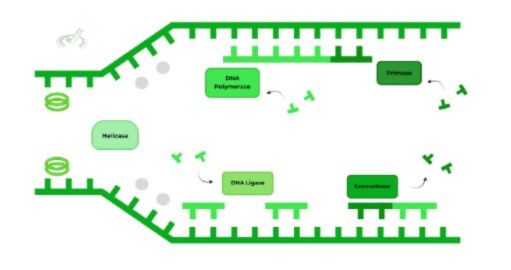
All the enzymes mentioned in the diagram above are important to DNA replication. However, the most important to know are these four:
Enzyme | Description |
|---|---|
Primase | RNA polymerase that lays the RNA primers. Eukaryotic cells need these RNA primers as DNA polymerases have not evolved to initiate DNA strand synthesis without needing an RNA primer. |
DNA Polymerase | An enzyme that allows for synthesizing of the DNA daughter strand via a nucleophilic substitution reaction. Reads the template strand in the 3’to 5’ direction, which is why DNA strand synthesis only proceeds in the 5’-3’ direction. |
Exonuclease | Enzyme that removes the RNA primers to ensure that only DNA is present within the daughter strands. |
DNA Ligase | Enzyme that joins the Okazaki fragments on the lagging strand, after RNA primers are removed by exonuclease enzymes. |
Full Study Notes : DNA Replication: Enzymes and Processes on the MCAT
For more in-depth content review on DNA replication enzymes and processes, check out these detailed lesson notes created by top MCAT scorers.
4. DNA: Role in Cancer Biology
Interestingly, cancer pathology often originates at the DNA level due to mutations leading to uncontrollable growth. This is mostly seen in the form of oncogenes and tumor suppressor genes:
Type of Gene | Function |
|---|---|
Oncogene | A gain of function in proto-oncogenes, genes involved in promoting normal cell growth, results in an oncogene. |
Tumor Suppressor Gene | The function of these genes is to inhibit cell growth when not necessary, acting similarly to check and balance proto-oncogenes. A loss of function in these genes results in unregistered cell growth. |
The gain of function in proto-oncogenes to oncogenes and the loss of function in tumor suppressors result in increased cell cycle progression.
Full Study Notes : DNA: Role in Cancer Biology on the MCAT
For more in-depth content review on role in cancer biology, check out these detailed lesson notes created by top MCAT scorers.
5. Chromosomes - Structure and Function
The chromosome comprises one molecule of DNA and a type of protein called histones. This histone interaction acts as an anchoring point to pack DNA, and it regulates gene expression.
The basic structural unit of chromosomes and chromatin are nucleosomes. These DNA-protein complexes consist of 4 pairs of histone proteins and the DNA molecule.
Now, the phrases chromatin and chromosome can be confusing. Let’s define them:
Term | Definition |
|---|---|
Chromatin | The DNA molecule wrapped around histone proteins or describes the form of DNA during interphase. |
Chromosome | When the DNA is in its most condensed and organized form, dominating during the processes of mitosis and meiosis. |
Full Study Notes : Chromosomes: Structure and Function on the MCAT
For more in-depth content review on chromosomes structure and function, check out these detailed lesson notes created by top MCAT scorers.
6. Chromosomes: Role in Genetics
In addition to chromosome structure, three other important terms in understanding chromosome’s role in genetics are:
Term | Description Definition |
|---|---|
Gene | The actual nucleotide sequence of DNA which codes for a protein or an RNA molecule |
Locus | The specific location of a gene on the chromosome (locus as in the location of a gene). |
Alleles |
Different versions or variations of the same gene |
Each individual has 23 pairs of chromosomes (46 chromosomes in total). Each pair consists of a maternal and paternal chromosome. These chromosomes are called homologous as the chromosomes both have the same gene on the same loci.
Since we have homologous chromosomes, we have 2 copies of each gene, which can give rise to multiple combinations of gene allelic variants. Understanding these alleles and their role in genetics contributed to the foundation of Punnett squares.
Full Study Notes : Chromosomes: Role in Genetics
For more in-depth content review on chromosomes role in genetics, check out these detailed lesson notes created by top MCAT scorers.
7. Gene Expression: Prokaryotes
Prokaryotic genes are termed polycistronic because each mRNA transcript can code for multiple proteins. Prokaryotic gene expression is regulated via the operon model, which contains 4 main genes/sequences.
The repressor gene codes for the repressor protein which binds to the operator region and the promoter is the sequence where RNA polymerase will bind to. The operator region is the sequence where the repressor protein will bind to and the structural gene codes for the protein of interest.
The most important concepts to keep in mind about the operon are the order in which the sequences are placed and the interaction between the repressor protein and the operator region. The operator region comes AFTER the promoter so, the RNA polymerase cannot transcribe the gene when the repressor protein is bound to the operator region because it blocks the RNA polymerase. Hence, gene expression is halted.
Operon models have two main categories – an inducible model and a repressible model, differing on whether it is constitutively active or inactive:
Category | Description |
|---|---|
Inducible Operon System – Positive Control in Bacteria | The repressor is constantly bound to the operator region, causing it to be constitutively inactive. |
Repressible Operon System – Gene Repression in Bacteria | The repressor protein is in a constant conformation where it cannot bind the operator region, causing it to be constitutively active. |
Full Study Notes : Gene Expression: Prokaryotes on the MCAT
For more in-depth content review on prokaryotes, check out these detailed lesson notes created by top MCAT scorers.
8. Gene Expression: Eukaryotes
To regulate transcription, there are DNA sequences that neighbor the main gene. Core promoters are involved in binding RNA polymerase II while enhancers/silencers are important for the binding of transcription factors.
Transcription factors will bind to enhancers and silencers, which will then regulate transcription by affecting the stability of RNA polymerase II. Transcription activating factors will bind to enhancer sequences to stabilize RNA polymerase II and increase transcription, whereas inhibiting factors will bind to silencer sequences to destabilize RNA polymerase II and decrease transcription.
In eukaryotes, epigenetic control of gene expression exists. This refers to the regulation of gene expression through chromatin modification. Two main types exist – DNA methylation and histone acetylation:
Type of Epigenetic Modification | Function |
|---|---|
DNA Methylation | When methyl groups are added to the DNA molecule. This process represses gene transcription which is essential for normal development. |
Histone Acetylation | The attachment of acetyl groups to amino acids of histone proteins. This removes the positive charges and reduces the affinity between histones and DNA, enhancing gene transcription. |
Full Study Notes : Gene Expression: Eukaryotes on the MCAT
For more in-depth content review on eukaryotes, check out these detailed lesson notes created by top MCAT scorers.
9. Nucleic Acids: Basics and Fundamentals
Similar to the other macromolecules, nucleic acids are also composed of repeating monomer subunits called nucleotides.
Nucleotides have 3 main components – a pentose (5 carbon) sugar, a nitrogenous base (bonded to C1 carbon), and phosphate (1 or more bonded to C5 carbon).
There are 2 types of nucleic acids – DNA and RNA. These are part of various cellular processes, including replication, transcription etc.
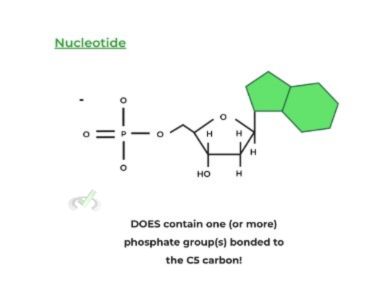
Nucleotides can also be differentiated based on their nitrogenous bases. These nitrogenous bases are broken down into 2 categories – purines (double-ringed consisting of adenine and guanine) and pyrimidines (single-ringed consisting of cytosine, thymine, and uracil).
Full Study Notes : Nucleic Acids: Basics and Fundamentals on the MCAT
For more in-depth content review on nucleic acid's basics and fundamentals, check out these detailed lesson notes created by top MCAT scorers.
10. Mutations: Nucleotide Level and Chromosomes
There are two levels of mutations – nucleotide level and chromosome level mutations.
Nucleotide mutations are changes within the bases of specific nucleotides. They can be further divided into point or frameshift mutations.
Chromosomal level mutations differ from nucleotide mutations as they deal with larger genetic DNA segments of the chromosome. They can be further divided into single-chromosome or double-chromosome mutations.
Full Study Notes : Mutations: Nucleotide Level and Chromosomal on the MCAT
For more in-depth content review on nucleotide level and chromosomal, check out these detailed lesson notes created by top MCAT scorers.
11. RNA Transcription: Fundamental and Key Terms
The central dogma of molecular biology states that for a protein to be produced, DNA must be transcribed into an mRNA transcript, which is then translated into the protein.

When being translated in the ribosome, the mRNA is read in 3 nucleotide sets called codons. Each codon codes for either a single amino acid to grow the protein or a stop codon to terminate the translation.
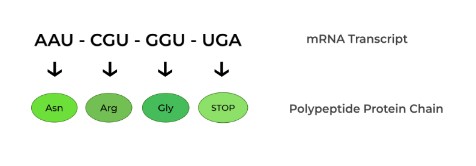
Full Study Notes : RNA Transcription: Fundamentals and Key Terms on the MCAT
For more in-depth content review on RNA transcription fundamentals and key terms, check out these detailed lesson notes created by top MCAT scorers.
12. RNA Transcription: Enzymes and Processes
RNA transcription involves the synthesis of mRNA transcripts from genetic DNA sequences that code for proteins, RNA structures, and more. The main enzyme involved in RNA transcription is RNA Polymerase II, which has both helicase and polymerase activity to unwind and transcribe the DNA. Unlike DNA polymerase, RNA polymerase does not need a primer and can add nucleotides without the need of an existing strand.
After transcription, the mRNA needs to undergo modifications, such as the addition of the 5’-methylguanosine cap and the 3’-polyA-tail, which protect the mRNA from degradation by exonucleases in the cytoplasm.
Another modification is alternative splicing, pre-mRNA still contains introns, so the spliceosome will splice out these non-coding regions, so the mature mRNA only contains exons.
Full Study Notes : RNA Transcription: Enzymes and Processes on the MCAT
For more in-depth content review on RNA transcription enzymes and processes, check out these detailed lesson notes created by top MCAT scorers.
13. Translation: Fundamentals and Key Terms
One way we like to think of translation is going from something much smaller in the form of DNA and RNA to something much larger and more directly involved in cellular processes, that being a protein.
Full Study Notes : DNA RNA Translation: Fundamentals and Key Terms on the MCAT
For more in-depth content review on translation fundamental and key terms, check out these detailed lesson notes created by top MCAT scorers.
14. Translation: Processes
The entire process of translation can be subdivided into 3 main stages: initiation, elongation, and termination.
During Initiation, proteins called initiation factors (IF) will aid in the binding and aligning of the mRNA transcript to the ribosome. Prokaryotic ribosomes recognize the Shine-Dalgarno sequence to facilitate binding while eukaryotic ribosomes recognize the 5’-methylguanosine cap.

Elongation occurs when a new, charged tRNA enters the A site and the enzyme peptidyl transferase transfers the growing polypeptide chain onto the new amino acid in the A site.
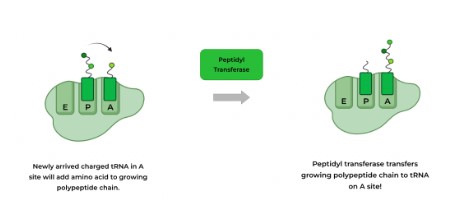
Now, the tRNA in the P site is uncharged and the tRNA in the A site contains the polypeptide chain. From here, the tRNAs “shift positions” to where the uncharged tRNA now lies in the E site for exit and the polypeptide tRNA is repositioned in the P site. Another charged tRNA can enter into the A site, restarting the process until translation is terminated
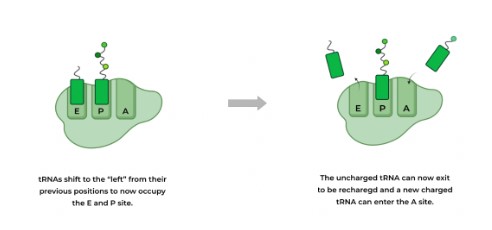
The third and final step is termination. Upon recognition of one of the stop codons, UAA, UAG, or UGA, translation will terminate. Release and termination factors will then aid in the hydrolysis and release of the polypeptide chain.
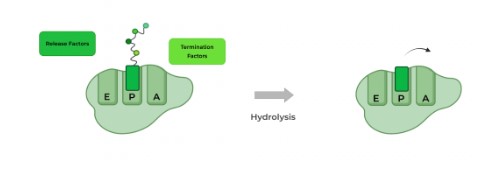
Full Study Notes : DNA RNA Translation: Processes on the MCAT
For more in-depth content review on translation processes, check out these detailed lesson notes created by top MCAT scorers.
Key Terms and Definitions – DNA and RNA
Here are some of the more important key terms and definitions to remember for this general guide to DNA and RNA!
Term | Definition |
|---|---|
DNA | The molecule inside cells that contains the genetic information responsible for the development and function of an organism. |
RNA | Nucleic acid present in all living cells that has structural similarities to DNA. Unlike DNA, however, RNA is most often single-stranded. |
Transcription |
The process where a cell makes an RNA copy of a piece of DNA. This RNA copy, called messenger RNA (mRNA), carries the information from the DNA in the nucleus of the cell to the cytoplasm, where proteins are made. |
Translation |
The process where a cell makes proteins using the genetic information carried in messenger RNA (mRNA). |
Replication |
The process by which the genome’s DNA is copied in cells. |
Chromosome |
A structure found inside the nucleus of a cell. A chromosome is made up of proteins and DNA organized into genes. Each cell normally contains 23 pairs of chromosomes. |
Mutations |
A change in the DNA sequence of an organism. Mutations can result from errors in DNA replication during cell division, exposure to mutagens or a viral infection. |
Eukaryotes |
Any cell or organism that possesses a clearly defined nucleus. |
Prokaryotes |
Organisms whose cells lack a nucleus and other organelles. |
Nucleic acid |
Large biomolecules that play essential roles in all cells and viruses. |
Helicase |
DNA replication enzyme that works to unwind the DNA strands at the origin |
Replication Fork |
Describes the structure/shape that’s formed due to the unwinding of DNA during replication. |
Leading Strand |
This is the continuous strand. Has a template strand starting with a 3’ end, so it can replicate without interruptions and does not need fragments. |
Lagging Strand |
This is the discontinuous strand. This has a template strand starting with a 5’ end, so it cannot replicate without interruptions, it requires the use of Okazaki fragments. |
Telomere |
The repeated nucleotide sequence of 5’-TTAGGG-3’ acts as a cap to prevent the loss of genetic information after each DNA replication cycle. Telomeres originated as a result of evolution. |
Nucleotide |
Organic molecules that serve as the basic structural units for DNA and RNA. Consisting of the Base (Adenine, Thymine, Cytosine, Guanine) + sugar + phosphate |
Additional FAQs – DNA on the MCAT
What is meant by DNA → RNA → protein?
What is the Meaning of 3’ → 5’ and 5’ → 3’ in DNA Strand?
What does DNA Methylation do MCAT?
What is the TATA box MCAT?
As indicated by the name, the sequence contains a high amount of repeating thymine (T) and adenine (A) bases.
Additional Reading Links – Study Notes for DNA and RNA on the MCAT
For more in-depth content review about DNA and RNA on the MCAT, check out these detailed lesson notes created by top MCAT scorers!
Additional Reading: Biochemistry Subjects on the MCAT:
- Biological Membranes on the MCAT
- Carbohydrate Metabolism on the MCAT
- Carbohydrate Structure on the MCAT
- Amino Acids Peptides Proteins on the MCAT
- Enzymes on the MCAT
- Lipids and Lipid Metabolism on the MCAT
- Non-Enzymatic Proteins on the MCAT
- Regulation of Metabolism on the MCAT
- Biotechnology on the MCAT
- Bioenergetics on the MCAT


 To help you achieve your goal MCAT score, we take turns hosting these
To help you achieve your goal MCAT score, we take turns hosting these